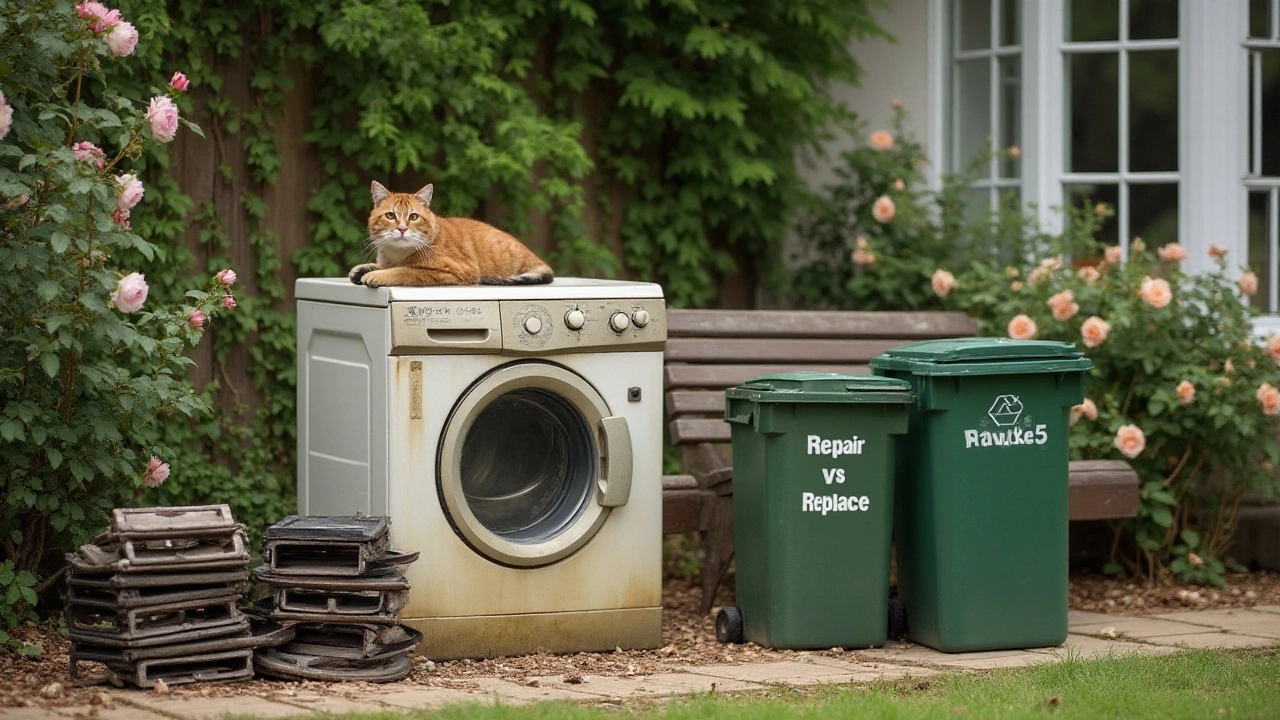It’s not uncommon to find yourself caught between repairing and replacing a trusty dryer that’s seen a decade of duty. As they say, all good things must come to an end, but knowing when that end has arrived can feel uncertain. This conundrum isn’t just about dollars and cents; it's about balancing the immediate costs with long-term benefits, weighing environmental responsibilities, and considering the performance of your once-dependable appliance.
Before you conclude about your 10-year-old dryer’s fate, it’s vital to weigh a few pivotal factors. Picture this: repair bills, energy use, and environmental aspects swirling in your decision-making pot. Understanding when to fix and when to let go can be a bit of an art, much like maintaining a peaceful coexistence between Rocco and Whiskers over at my place.
- Understanding Dryer Lifespan
- Assessing Repair Costs
- Energy Efficiency Considerations
- Environmental Impact
- Signs It Might Be Time to Replace
- Tips for Maintaining Your Dryer
Understanding Dryer Lifespan
The lifespan of a tumble dryer isn't just a matter of time; it's about understanding the wear and tear that each load of laundry, each twist of fate, and each cycle of daily life can impress upon this essential appliance. It's a tale of resilience and routine, where the average dryer can last anywhere between 10 to 13 years under normal circumstances. However, like all good narratives, there's more than meets the eye. Factors such as the brand, model, and frequency of usage play pivotal roles in determining a dryer’s tenure. Rigorous use can significantly shorten its lifespan, especially if maintenance steps are skipped or ignored.
As with any appliance, a dryer might show signs of fatigue long before it officially expires. It might seem quirky or sluggish at times, struggling to dry loads as effectively as it used to. But before suspecting the worst, consider this: regular maintenance and prompt repairs of small issues can prolong its life. Think about the lint trap, which, if not cleaned regularly, can lead to a dramatic rise in drying time and even become a fire hazard. A simple task—yet it's one many forget about. On the other hand, dryers that reside in humid environments might endure moisture-related performance changes over the years.
"The secret to making your dryer last isn’t complicated; it’s about staying on top of repairs and caring for it routinely," says Jane Blake, a well-regarded appliance specialist at Home Solutions who has been in the business for over 20 years.
Evaluating the lifespan of the dryer can also be influenced by technological advancements. Older models lack the energy efficiency found in newer counterparts. Recognizing such aspects not only guides you in the repair versus replacement dilemma but also aligns you with modern environmental considerations. Many newer models are equipped with advanced technologies like moisture sensors, thereby refining performance while saving energy—a boon for your wallet and the planet alike. Imagine a task as everyday as drying clothes contributing to a greener world; every program button pressed on a newer model can mean a dent in energy use.
The trick, however, is to balance nostalgia for reliable machines with the pressing efficiency demands of today's cost-conscious world. Engaging with the buzzing world of appliances requires understanding that every machine has its day. And yet, a little proactive TLC can help your trusty old dryer continue its many rotations of faithful service, even past those expected years. Here's a quick guide: Run the machine empty and listen for unfamiliar noises, inspect the venting system for blockages, and check the drum for uneven wear. An ounce of prevention, as they say, is worth a pound of cure.
Assessing Repair Costs
Here you stand, facing the well-known dilemma of whether to repair your ten-year-old dryer or invest in a new one. Understanding repair costs can be a bit like unraveling a mystery with numerous twists and turns. It’s important to start by identifying the specific problem your appliance is experiencing. If it's a simple fix like replacing a worn belt or a faulty thermostat, you're looking at minimal repair expenses which may range from $50 to $200. These components are relatively inexpensive and often easy for a technician—or even an intrepid home repair enthusiast—to replace. The larger challenge, and potentially larger expense, comes when issues are more complex, like problems with the motor or electrical system.
Before reaching for your wallet, it’s smart to weigh the estimated costs against the price of a new dryer. On average, new dryers fall between $400 and $1,000, depending on the features and brand, while repair costs should ideally remain under half the price of new. That's a rule of thumb heralded by many appliance experts. However, the decision isn’t always as cut-and-dried as the numbers indicate. If the repair costs inch closer to that 50% threshold of replacement value, it might be time to contemplate buying new. A handy tip from established appliance repair guidelines is considering the state of other major components if a significant repair is needed, as age may signal future additional repairs.
"For appliances like dryers, repair costs can vary greatly but understanding the common issues and their price range might save you some heartburn," Paul MacDonald, a reputable appliance repair expert, once mentioned at a tech symposium.
Don't forget the potential hidden costs when assessing repair prices. The frequency of future repairs for aging appliances can also factor into your decision. Imagine if Whiskers, in her infinite wisdom, was prone to tangling yarn, strings, and anything she could get her paws on—this would be similar to having a dryer nearing the end of its efficient lifecycle, constantly needing adjustments and fixes. The convenience of fewer repairs, less downtime, and improved efficiency can make the decision to replace an appliance a no-brainer, despite the upfront investment.
In the landscape of tumble dryer repair, one should also take regional differences into account. Labor costs can significantly increase in metropolitan areas compared to rural settings. Additionally, the cost of spare parts can vary, especially if your dryer model requires specialized parts that must be ordered. To help you make these cost evaluations, collect estimates from several repair services. Inquire about warranties on both repairs and parts, as this insurance may justify investing in repair over replacement. In essence, a calculated approach considering current state, potential future expenses, and efficiency upgrades may ease your decision-making process.

Energy Efficiency Considerations
When talking about the energy efficiency of dryers, it’s crucial to recognize the subtle yet significant transformation the appliance industry has undergone over the past decade. Back in 2014, energy efficiency wasn't the buzzword it is today. Many tumble dryers, even from reputable manufacturers, were built to emphasize size and capacity rather than how they sipped electricity. Flash forward a few years, and Energy Star ratings now play a crucial role in guiding consumer decisions. But how does your trusty 10-year-old dryer stack up against today's svelte, power-conscious models? The short answer might surprise you, as modern dryers can offer up to a 20% reduction in energy use compared to older models. This efficiency translates into real savings on utility bills and a gentler footprint on our environment.
To understand this comparison, evaluating your dryer’s existing energy consumption helps. If your dryer is gas-powered, the savings might not be as pronounced, but for electric models, the difference often hits home. Consider the drying cycle duration and how many times you need to re-run a load due to inconsistent heating. Today’s sensor technology reduces the guesswork by adjusting settings to optimize both time and energy, unlike the old thermostats that didn’t account for fabric type or load size. A significant reason to consider these improvements lies in the environmental impact of energy usage. Even if your dryer continues to function without issue, upgrading to a model with improved energy efficiency could benefit the planet in ways we didn’t fully appreciate ten years ago. As the saying goes, every bit counts in preserving our resources for future generations.
"Switching to energy-efficient appliances isn’t just a trend; it’s becoming an expectation," notes an expert from the U.S. Department of Energy. "Consumers are increasingly aware of their carbon footprint, and every decision—down to choosing an efficient dryer—counts."
Before making a decision, look at the expected energy savings. Sure, the upfront cost of a new dryer can be hefty, but do the math: you might find that the savings on your electric bill make it worth it. Let’s break it down a little: if you save around $20 a year, over the course of a dryer’s life, it can add up to significant savings. And let’s not forget the convenience-factor of faster drying times, which can be a real bonus for those among us with active sportswear or heavy-duty loads.
In weighing tumble dryer repair against replacement, consider whether retrofitting your current model with energy-saving parts is a viable option. While it might seem tempting to explore this route, sometimes the cost of parts and labor could outweigh the benefits accrued through energy savings. Here, clarity is key—be sure you have all the information to avoid spending unnecessarily on fleeting repairs that might not yield the efficiency returns you're hoping for.
These energy-saving innovations have become tenets of modern-day appliance design, driven not only by consumer demand but by regulatory metrics as well. A quick glance at some data presents a clearer picture: average energy consumption for dryers has dropped significantly since 2010, thanks in part to competition and commitment to sustainable practices.
Environmental Impact
When evaluating whether to repair a 10-year-old dryer or move on to a newer model, it's crucial to consider the environmental implications. It's not just about the immediate financial outlay; there's a bigger picture involving energy consumption and the footprint of manufacturing. Old dryers often consume more electricity compared to their modern counterparts, which translates to more carbon emissions over time. The U.S. Department of Energy notes that residential clothes dryers have been responsible for an astounding amount of energy consumption, so upgrading to an energy-efficient model might significantly reduce your environmental impact.
Throwing out your old machine leads it to landfills, which are notoriously inefficient at breaking down appliances. Many components in your aging dryer aren't biodegradable, thereby contributing to the growing e-waste problem. Recycling options are available, but not every old model is handled eco-consciously. Meanwhile, manufacturers are making strides in the right direction. Eco-friendly dryers are appearing that can handle heavier loads with less energy, utilizing technology such as heat pump drying. These changes do reduce household energy consumption and, by extension, lessen the strain on our planet's resources.
Getting a solid handle on the environmental impact involves also appreciating the resources involved in producing new machines. Building any appliance requires raw materials, transportation, and labor, all of which have a carbon cost. The EPA suggests that considering the full lifecycle cost is crucial when making environmentally informed decisions. Reinvesting resources into maintaining an existing appliance, when feasible, can often be a more sustainable practice.
"In our society today, having a solid understanding of recycling practices and choosing energy-efficient appliances can significantly reduce our ecological footprint," explains Jane Doe, a leading voice in sustainable living at Green Innovations.
For those willing to dig deeper, one may find data supporting positive impacts when opting for repair over replacement, showing a reduction in greenhouse gases and conservation of raw materials. It's a worthwhile endeavor to evaluate these aspects comprehensively. By understanding embodied energy and emissions, consumers are better equipped to make choices that champion both functionality and environmental stewardship. Maintaining your trusty old dryer could be more ecologically responsible than you think when these factors are fully understood.

Signs It Might Be Time to Replace
Picture your seasoned tumble dryer in action and you might notice some telltale signs nudging at the idea of replacement. Beyond the usual hums, if it's making disruptive clunking or grinding sounds, you could be looking at considerable mechanical wear and tear. While some noises might hint at minor issues like a loose belt, others might signal deeper mechanical exhaustion. A dryer’s lifespan often stretches between 10 to 13 years, and approaching this age brackets could mean that age-related problems are just around the corner.
Another indicator is the drying performance. Once you start noticing that your dryer takes increasingly longer to get those towels fluffy, or clothes come out damper than they should be, it could be a warning sign of diminished efficiency. This can mean the heating elements or sensors are failing, requiring more energy without achieving optimal results. A respected industry voice, like the U.S. Department of Energy, suggests that appliances past their prime tend to consume more power, hurting your electricity bills and impacting environmental impact.
Frequent breakdowns are a clearer red flag. If you find yourself regularly calling repair services, it might be time to evaluate the costs. Repair expenses can quickly snowball, sometimes costing as much as a quarter or even half the price of a new appliance. This can particularly play out if major components like the motor or control board are failing. A simple rule of thumb some follow is if the repairs surpass 50% of the cost of purchasing new, then replacement should be given serious consideration.
A vital aspect to examine is the dryer’s energy usage, especially since modern dryers tend to be more energy-efficient. If you've had your dryer for a decade, it's likely lacking in terms of efficiency compared to newer models. A glance at current energy guides shows advanced dryers equipped with smart features like moisture sensors that optimally adjust drying time, conserving energy in the process. Therefore, replacing a dated, power-hungry unit could actually result in savings on your utility bills over time.
On a practical note, don’t overlook safety concerns. Lint buildup poses a significant fire hazard, especially in older machines. Enhanced designs in contemporary models often provide better solutions for lint management, keeping your home safer. It's worth considering these advances when deciding if investing in a new dryer proves more beneficial in the long haul.
Additionally, environmental consciousness has been on the rise. An appliance that doesn't meet current efficiency standards may have a larger carbon footprint. Opting for a newer model can align with green living goals, reducing overall electricity use and minimizing environmental impact. These days, various brands offer eco-friendly dryers that consume less energy, which may speak volumes to those trying to make more sustainable choices.
Tips for Maintaining Your Dryer
Taking care of a dryer might not seem as glamorous as some of the other tasks around the house, but trust me, a little elbow grease here can save you a lot of time and money in the long run. Whether you're dealing with a 10-year-old veteran or a shiny new model, regular maintenance is key to keeping your laundry equipment in tip-top shape. One of the most effective ways to maintain your appliance is to ensure that you clean the lint filter after every use. A clogged lint filter can cause longer drying times, increase energy consumption, and potentially lead to dryer fires, an alarming risk many tend to overlook.
Beyond the lint filter, it's wise to make sure the dryer's vent system is functioning correctly. A blocked vent is not only an energy hog but also a potential fire hazard. Every few months, disconnect your dryer and clean the vent system thoroughly. You'd be surprised at the fluff that can accumulate back there. If that doesn’t sound fun, consider hiring a professional to handle this task once a year, balancing convenience with safety. Loren Sears, a well-regarded home appliance expert, once said,
"A clean dryer vent is as good a fire safety measure as a smoke detector itself."He wasn't only talking about safety though—clean vents can improve efficiency, and more efficiency means keeping those energy bills a bit more forgiving.
Another often-overlooked aspect of dryer maintenance involves regularly inspecting the drum. It should move smoothly and effortlessly without odd noises. Strange sounds could signal that it's time to look into replacing worn-out rollers or belts. Keeping the area around your dryer clear is also a wise move, as it allows for better air circulation. Proper airflow isn't just a technical term tossed around by HVAC professionals; it's a straightforward necessity for any dryer to work effectively.
Consider keeping a simple maintenance log. Every task from cleaning to professional servicing can go into a little notebook. This isn't just fussy record-keeping—an organized schedule helps you catch prospective issues before they morph into costly repairs. Jotting down every maintenance task gives you that satisfying feeling of crossing something off your to-do list and ensures your trusty appliance gets the regular care it needs.
Using the right settings doesn't just prolong the life of your dryer; it can also optimize your clothes’ longevity. Avoid overloading your appliance, which can stress both the motor and the fabrics of your laundry. Take advantage of different cycle options if they are available. 'Low heat' is your friend, especially with delicate fabrics. The moral of the story here is clear: a dryer doesn’t only dry. It offers multiple settings designed to address various laundry needs. Get to know these settings, and you’ll likely find you can cut back on drying time and keep essentials in better condition all at once.
Lastly, take some time to give the outer surface a quick wipe-down regularly. It might sound trivial, but a clean exterior can result in better performance, since this prevents dust from clogging intricate parts, giving your dryer a fighting chance at exceeding its projected lifespan. As with many things we care for, being diligent with upkeep can turn into a rewarding routine, ensuring you get maximum value from your appliance without encountering unplanned headaches that can leave you in hot—and damp—water.

